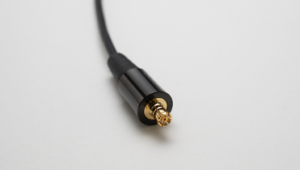Question: Why does Audio-Technica use the A2DC connector for many of its headphones with detachable cables?
Answer: Dissatisfied with existing connectors for detachable headphone cables, Audio-Technica developed the A2DC connector to provide a durable, stable connection that delivers the best sound quality possible. The potential for this connector is not limited to Audio-Technica products, and we hope that many more headphone and cable companies will recognize the connector’s superior performance and begin to use it in their own products as well.
In-ear headphones with detachable cables have become extremely popular, and one of the reasons for this is that users can interchange cables – switching from an unbalanced to a balanced cable, for instance – to get the sound they want. Other manufactures have adopted the MMCX (microminiature coaxial) connector for headphone cables. Audio-Technica initially used this connector for the ATH-CK100PRO, released it in 2011, but we encountered the same problems that many others have experienced with this connector.
The MMCX was originally designed for wireless devices and not intended for audio-dedicated applications. Once the connectors became widely used in the headphone industry, problems with the connection became apparent: it is often either too loose and disconnects easily or it fits too tightly and is hard to pull apart. There are also issues with the connectors rotating. A structural problem prevents the male and female sides from connecting completely if the connectors move, which can result in sound dropouts or unwanted noise. Even when the connectors are within the range of tolerance (margin of error for the dimensions as allowed by the standard), there may be cases where the connectors do not fit together well enough to function reliably for audio purposes.
Audio-Technica’s Product Development Team identified a need for a connector that was specifically designed for in-ear headphone cables and would address the issues with the existing connectors. A wide variety of types, shapes, materials, and designs were developed and tested. The IM Series in-ear headphones, which were released in 2013, did not use the MMCX connector, but rather adopted a proprietary 2-pin connector. Whereas the connection stability of this 2-pin connector was superior to the MMCX, there was still the issue of ease of attachment and disconnection. The team also wanted a connector that could be used with over-ear headphones, so they changed course and began to develop what would become the A2DC connector.

The A2DC connector is a coaxial structure based on the MMCX, and although its external appearance is similar, it differs from the MMCX in a number of ways. Typically with MMCX connectors there is a pin in the center of the male connector, surrounded by an outer ring. There is a pin receptor located in the center of the female side. Conductance occurs when the central pin (inner conductor) and surrounding ring (outer conductor/ground) of the male connector attach to their respective female connectors. The structure of the A2DC connector, however, is such that the male-side ring section (outer conductor/ground) is partitioned into tabs that face and press outward with spring-like action. In this way, the male-side ring section attaches more reliably to the receptor on the female-side ring, resolving the problem of the two sides not connecting completely. This new design remains strong even with repeated attaching and detaching, ensuring a stable connector that lasts.
Unlike the MMCX connector, the A2DC connector’s central pin is on the female side, and the center of the male side has a pin receptor. Additionally, the area surrounding the pin receptor is reinforced with plastic, which prevents the pin receptor from spreading out and the pin from breaking. The A2DC connector is larger than the MMCX connector, and its ring section is longer and larger in diameter. This ensures a larger connection area, greater stability, lower impedance, and improved sound quality compared to other connectors, especially as this connection is used on a wide variety of headphones ranging from portable in-ear models to audiophile over-ear models such as our flagship open-air headphones, the ATH-ADX5000.
Another strength of the A2DC connector is that the connection part does not easily rotate. Typically, MMCX connectors have little rotation resistance and tend to rotate if turning pressure is applied to the connecting part. Such rotation makes the connection less stable and also wears down the connector. A worn connector collects dirt, which can generate unwanted noise. With the A2DC connector, the ring section spreads outward, increasing rotation resistance. Therefore, it is more difficult to unintentionally rotate the connector, resulting in a more stable connection that’s less prone to wear.
In 2016, Audio-Technica released the HDC series of replacement cables, which use the A2DC connectors. The various models offer different output connectors, including the standard 3.5 mm plug, as well as 2.5 mm and 4.4 mm balanced connectors.
However good the conductance of a cable, it will be meaningless if the connection is not stable. Maintaining a secure connection eliminates sound dropouts and helps deliver the best sound quality possible. The cables in the HDC series use 6N OFC wire for pure signal transmission and have a twisted structure that helps to reduce noise. And since different headphones perform differently, the HDC cables are individually tuned to bring out the best performance in specific headphone models.
As with any new standard, third-party options with A2DC connectors may be limited. But we are beginning to see other manufacturers use A2DC connectors in their replacement cables, and it is our hope that these connectors will become even more common as time goes by.
If you have additional questions about our A2DC connectors or our replacement cables, please contact the Audio Solutions Department.